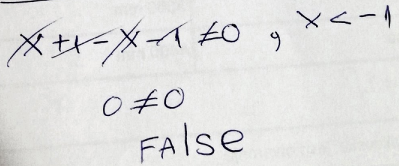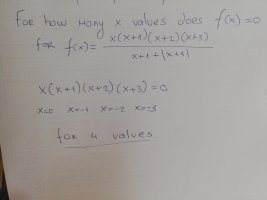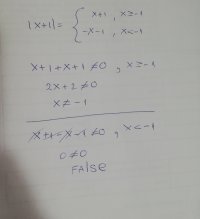You are using an out of date browser. It may not display this or other websites correctly.
You should upgrade or use an alternative browser.
You should upgrade or use an alternative browser.
When f(x) =0
- Thread starter Loki123
- Start date
BigBeachBanana
Senior Member
- Joined
- Nov 19, 2021
- Messages
- 2,181
What's the domain of the function?This might be stupid to ask, but I really want to check If I did this correctly. I am concerned that the absolute somehow influences the solution. View attachment 32536
X>-1?What's the domain of the function?
Attachments
topsquark
Senior Member
- Joined
- Aug 27, 2012
- Messages
- 2,269
x can't be -20? On the other hand is x + 1 + |x + 1| ever 0?X>-1?
-Dan
Dr.Peterson
Elite Member
- Joined
- Nov 12, 2017
- Messages
- 16,089

Think very carefully! What are you saying is false here? Are you saying that no value is excluded from the domain, or that no value is in the domain? Or something else?
You probably mean the right thing, though it is not entirely clear, because you omitted details of your reasoning. If so, what is your final answer to the problem?
Incidentally, another way to approach this would be just to check each of your originally claimed zeros by putting them into the function.
You are, I think, allowing yourself to get tied up unnecessarily by your uncertainty about absolute values. I do not understand EXACTLY what your writing is supposed to mean.
The basic idea is that a function with absolute values is effectively defined piecewise.
[math]\text {sgn}(x + 1) = - 1 \implies |x + 1| = - (x + 1) \implies\\ f(x) = \dfrac{x(x + 1)(x + 2)(x + 3)}{x + 1 + |x + 1|} = \dfrac{x(x + 1)(x + 2)(x + 3)}{x + 1 - (x + 1)} \not \in \mathbb R.[/math]
So we can say that this function does not exist where
[math]x + 1 < 0 \implies x < - 1.[/math]
I think that is what you were getting at.
[math]\text {sgn}(x + 1) = 1 \implies |x + 1| = (x + 1) \implies\\ f(x) = \dfrac{x(x + 1)(x + 2)(x + 3)}{x + 1 + |x + 1|} = \dfrac{x(x + 1)(x + 2)(x + 3)}{x + 1 + (x + 1)} =\\ \dfrac{x(x + 1)(x + 2)(x + 3)}{2(x + 1)}[/math].
You have no domain issues if [imath]x + 1 > 0 \implies x > - 1[/imath].
What happens if x = - 1?
The basic idea is that a function with absolute values is effectively defined piecewise.
[math]\text {sgn}(x + 1) = - 1 \implies |x + 1| = - (x + 1) \implies\\ f(x) = \dfrac{x(x + 1)(x + 2)(x + 3)}{x + 1 + |x + 1|} = \dfrac{x(x + 1)(x + 2)(x + 3)}{x + 1 - (x + 1)} \not \in \mathbb R.[/math]
So we can say that this function does not exist where
[math]x + 1 < 0 \implies x < - 1.[/math]
I think that is what you were getting at.
[math]\text {sgn}(x + 1) = 1 \implies |x + 1| = (x + 1) \implies\\ f(x) = \dfrac{x(x + 1)(x + 2)(x + 3)}{x + 1 + |x + 1|} = \dfrac{x(x + 1)(x + 2)(x + 3)}{x + 1 + (x + 1)} =\\ \dfrac{x(x + 1)(x + 2)(x + 3)}{2(x + 1)}[/math].
You have no domain issues if [imath]x + 1 > 0 \implies x > - 1[/imath].
What happens if x = - 1?
x can't be -20 because if x<-1 we are diving by 0.You have the condition that [imath]x \neq 1[/imath]. Why are you saying that the domain is x > -1?
Again, can x = -20?
-Dan
the domain has to be x>=-1, but we exclude -1 because it's 0 for that too. So x>-1
if we have x<-1, we are diving by 0 which is not possible.View attachment 32540
Think very carefully! What are you saying is false here? Are you saying that no value is excluded from the domain, or that no value is in the domain? Or something else?
You probably mean the right thing, though it is not entirely clear, because you omitted details of your reasoning. If so, what is your final answer to the problem?
Incidentally, another way to approach this would be just to check each of your originally claimed zeros by putting them into the function.
if it's x=-1 we are dividing by 0. So the domain is x>-1You are, I think, allowing yourself to get tied up unnecessarily by your uncertainty about absolute values. I do not understand EXACTLY what your writing is supposed to mean.
The basic idea is that a function with absolute values is effectively defined piecewise.
[math]\text {sgn}(x + 1) = - 1 \implies |x + 1| = - (x + 1) \implies\\ f(x) = \dfrac{x(x + 1)(x + 2)(x + 3)}{x + 1 + |x + 1|} = \dfrac{x(x + 1)(x + 2)(x + 3)}{x + 1 - (x + 1)} \not \in \mathbb R.[/math]
So we can say that this function does not exist where
[math]x + 1 < 0 \implies x < - 1.[/math]
I think that is what you were getting at.
[math]\text {sgn}(x + 1) = 1 \implies |x + 1| = (x + 1) \implies\\ f(x) = \dfrac{x(x + 1)(x + 2)(x + 3)}{x + 1 + |x + 1|} = \dfrac{x(x + 1)(x + 2)(x + 3)}{x + 1 + (x + 1)} =\\ \dfrac{x(x + 1)(x + 2)(x + 3)}{2(x + 1)}[/math].
You have no domain issues if [imath]x + 1 > 0 \implies x > - 1[/imath].
What happens if x = - 1?
BigBeachBanana
Senior Member
- Joined
- Nov 19, 2021
- Messages
- 2,181
You're correct. What does that tell you about the solutions in the OP?X>-1?
that only x=0 is correct.You're correct. What does that tell you about the solutions in the OP?
Correct. So if x > - 1, under what circumstances can f(x) = 0if it's x=-1 we are dividing by 0. So the domain is x>-1
only x=0Correct. So if x > - 1, under what circumstances can f(x) = 0
Correctonly x=0
But what I hope you REALLY gained from this was understanding how to treat absolute values in a function
yes i did! thank you so muchCorrect
But what I hope you REALLY gained from this was understanding how to treat absolute values in a function



